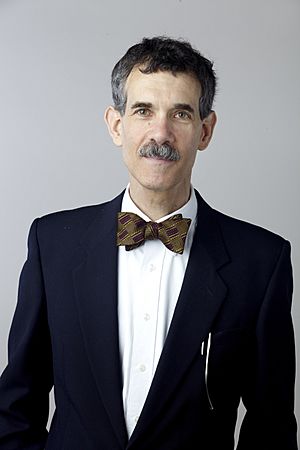David Ron facts for kids
Quick facts for kids
David Ron
|
|
|---|---|

Portrait via the Royal Society (2014)
|
|
| Born | 1955 Israel
|
| Alma mater | Technion – Israel Institute of Technology |
| Spouse(s) | Anne Crozat |
| Children | Thomas Ron |
| Awards |
|
| Scientific career | |
| Fields | |
| Institutions | |
| Academic advisors | Joel F. Habener |
David Ron is a well-known British biochemist. He studies how tiny parts inside our cells work. His research helps us understand diseases better. He is a Fellow of the Royal Society (FRS), which is a very high honor for scientists.
Contents
About David Ron's Life
Growing Up in a Science Family
David Ron was born in Israel in 1955. He grew up in a family where science was very important. His parents, Arza and Amiram Ron, were both professors. They taught Chemistry and Physics at the Technion university. David's younger sister, Dana Ron Goldreich, is also a computer scientist. She works at Tel Aviv University. David finished high school in Haifa, Israel, in 1972.
His Journey in Medicine and Research
David Ron earned a medical degree in 1980 from the Technion in Israel. After that, he moved to New York City. He completed his medical training at Mount Sinai Medical Center. This training included an internship and residency. These are special programs where new doctors learn by working in hospitals.
Later, he specialized in Endocrinology. This is the study of hormones and the glands that make them. He did this training at Massachusetts General Hospital in Boston. He then spent four years doing advanced research. He worked with Joel Habener, a researcher at Harvard Medical School.
From 1992 to 2009, David Ron was a professor at New York University School of Medicine. In 2010, he moved to the University of Cambridge in the UK. There, he became a Wellcome Trust Principal Research Fellow. He is also a Professor of Cellular Pathophysiology and Clinical Biochemistry. His lab is at the Cambridge Institute for Medical Research.
What David Ron Researches
Understanding Cell Stress
David Ron's laboratory studies how cells deal with stress. Specifically, they look at a part of the cell called the endoplasmic reticulum. You can think of the endoplasmic reticulum (ER) as a factory inside the cell. Its job is to make and fold proteins correctly. Proteins are like tiny machines that do almost everything in our bodies.
Sometimes, proteins don't fold correctly. This can cause stress for the cell. David Ron's team researches how cells adapt to this problem. They want to know how cells handle a "burden of unfolded proteins." This research is very important. It helps us understand many diseases. These include problems with hormones and diseases that affect the brain.
Key Discoveries in Cell Biology
David Ron has made several important discoveries. He found out how cells control how many proteins they make. This helps cells match protein production to how well proteins are folding. He also discovered a key part of the cell's stress response. This response is called the UPR. It helps cells fix or get rid of misfolded proteins. His work shows how delicate the protein-folding process is. It also highlights how small problems can lead to big health issues.
Awards and Special Recognitions
Fellow of the Royal Society (FRS)
In 2014, David Ron was chosen as a Fellow of the Royal Society (FRS). This is one of the oldest and most respected science awards in the world. It means he is recognized for his amazing contributions to science. The Royal Society noted his work on how cells handle protein misfolding. They said his discoveries have helped us understand many diseases. These include hormone problems and brain diseases.
Fellow of the Academy of Medical Sciences (FMedSci)
David Ron also became a Fellow of the Academy of Medical Sciences (FMedSci) in 2013. This award recognizes his important work in medical science. The Academy highlighted his research on "ER stress." This is when the endoplasmic reticulum is under strain. His work has connected Cell Biology (how cells work) with Pathophysiology (how diseases affect the body). He identified important molecules that help cells respond to stress. Even though he trained as a doctor, he continues to do lab research to find cures for diseases.

